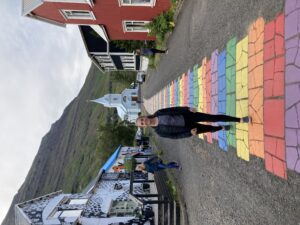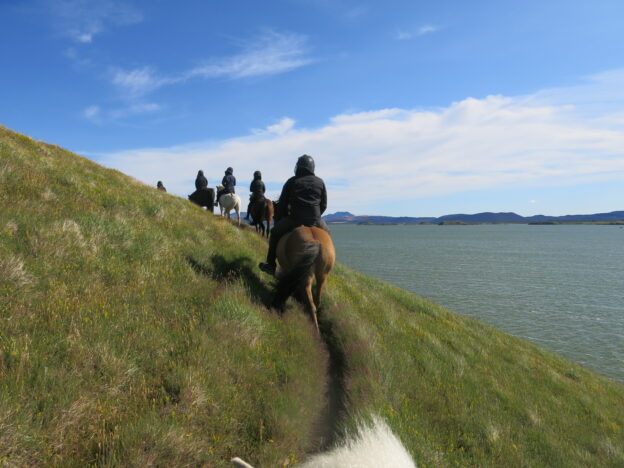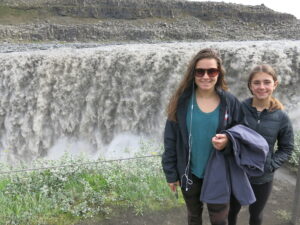 As Bob mentioned yesterday, we ended up canceling our 4 pm horseback ride due to the rain (which my iPhone told me was going to last for hours, but which actually cleared up about two minutes after I made the phone call). All was not lost, however, because we had a little extra time this morning and were able to squeeze in a 10 am ride before hitting the road.
As Bob mentioned yesterday, we ended up canceling our 4 pm horseback ride due to the rain (which my iPhone told me was going to last for hours, but which actually cleared up about two minutes after I made the phone call). All was not lost, however, because we had a little extra time this morning and were able to squeeze in a 10 am ride before hitting the road.
 Bob elected to skip this one, which was probably for the best. We meandered through stunning scenery, until we rounded a bend and found ourselves right on the edge of the lake — or, I should say, quite a long ways above the lake, with a very narrow path and a sheer drop off to our right. Our guide told us we were riding on the edge of a pseudocrater, which is a large, round bump that was formed long ago by bubbles in lava flows. Nadia and I were both very concerned
Bob elected to skip this one, which was probably for the best. We meandered through stunning scenery, until we rounded a bend and found ourselves right on the edge of the lake — or, I should say, quite a long ways above the lake, with a very narrow path and a sheer drop off to our right. Our guide told us we were riding on the edge of a pseudocrater, which is a large, round bump that was formed long ago by bubbles in lava flows. Nadia and I were both very concerned
about our horses taking a wrong step and plunging us down the slope into the waters far below, but fortunately they handled it like pros. This was not a trail that would be considered suitable for beginners in the U.S. (“No one has ever fallen off,” the woman who runs the farm later told me cheerfully. “If they did, we probably would not go there anymore.”) My midge-proof head net, which was actually necessary for the first time, blew off my head and I barely even noticed.
 We were also supposed to experience the “tolt”, which is a special gait unique to Icelandic horses. It’s kind of like a trot but supposedly much smoother and more comfortable for riding. I was very skeptical about this, because I found it plenty bumpy, but the kids later told me that my horse was rebelliously trotting rather than doing the tolt. Between the cliff ride and the trotting, I spent most of the ride holding onto the saddle with both hands like grim death.
We were also supposed to experience the “tolt”, which is a special gait unique to Icelandic horses. It’s kind of like a trot but supposedly much smoother and more comfortable for riding. I was very skeptical about this, because I found it plenty bumpy, but the kids later told me that my horse was rebelliously trotting rather than doing the tolt. Between the cliff ride and the trotting, I spent most of the ride holding onto the saddle with both hands like grim death.
After thanking our horses and our guides, and a quick visit to a week-old baby horse that our hostess was kind enough to introduce us to, we hit the road again. Today we made our way from the inland lake back out to the east coast, to an area called the Eastfjords. All along our route, you could barely turn your head without seeing a spectacular waterfall. The most spectacular of all, Detifoss, was a bit off our route, but well worth the detour. Google tells me it’s the most powerful waterfall in Europe, and this is easy to believe. Just a short walk down the road is another large waterfall, Selfoss — somewhat less powerful, but probably even more beautiful. We’ve been really struck by all the different waterfalls we’ve seen here — from massive, thundering falls to tall, lacy cascades.
We had to cross another high mountain pass on our way to our destination, Seydisfjorder. All our drives have been pretty breathtaking, but this one probably takes the prize. What with the steep drops and lack of guardrails, despite the beauty it was a relief to drop back down to this quaint little fjord-side town.
 We loved Seydisfjorder — a tiny, colorful village at the innermost point of the fjord, surrounded on three sides by high mountains streaked with waterfalls — from first glance. Our hostel is called the Old Hospital, and is in a beautifully restored historic building. There is a sauna in the basement and white-capped mountains towering outside our windows. We were almost disappointed to not be cooking dinner tonight, when we saw the lovely kitchen and dining areas on the first floor.
We loved Seydisfjorder — a tiny, colorful village at the innermost point of the fjord, surrounded on three sides by high mountains streaked with waterfalls — from first glance. Our hostel is called the Old Hospital, and is in a beautifully restored historic building. There is a sauna in the basement and white-capped mountains towering outside our windows. We were almost disappointed to not be cooking dinner tonight, when we saw the lovely kitchen and dining areas on the first floor.
 Luckily (especially since the grocery was closed) we actually managed to eat inside a restaurant for the first time on the whole trip. (Normally this would be because Bob and I are being cheap — the food here is VERY expensive — but really, this time around we’ve tried several times and been foiled for one reason or another.) A short stroll around the town and its lagoon, and we’re ready to call it a night. Onward and southward tomorrow!
Luckily (especially since the grocery was closed) we actually managed to eat inside a restaurant for the first time on the whole trip. (Normally this would be because Bob and I are being cheap — the food here is VERY expensive — but really, this time around we’ve tried several times and been foiled for one reason or another.) A short stroll around the town and its lagoon, and we’re ready to call it a night. Onward and southward tomorrow!









The town looks like a picture postcard! The pictures of the falls are awesome! The horseback riding sounded absolutely terrifying. Relieved it turned out all right.